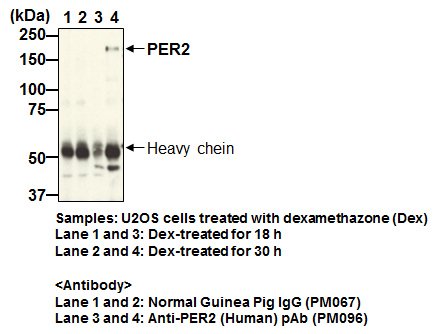Antibody detailed product information
| Code No. | PM096 | |
| Anti-PER2 (Human) pAb | ||
| Size | 50 µL | |
| Availability (in Japan) | 10 or more
(In Japan at 17:00, Apr 16, 2024 in JST) |
|
| Clonality | Polyclonal | |
| Clone | Polyclonal | |
| Isotype (Immunized Animal) |
Guinea pig Ig (aff.) | |
| Applications | WB 1:500 IP 2 µL/sample |
|
| Reactivity [Gene ID] | ||
| Storage buffer | TBS/50% glycerol, pH 7.5 | |
| Storage temp. | -20°C | |
| Conjugate | Unlabeled | |
| Manufacturer | MBL | |
| Alternative names | period circadian clock 2, FASPS, FASPS1, period2 | |
| Background | The circadian clock is a 24-hour endogenous oscillator, which cycles via transcriptional/translational feedback loops of clock genes and their products in individual cells. CLOCK and BMAL1 are positive factors in the loop, and their complex binds to E-box elements of Period (PER) and Cryptochrome (CRY) genes. In turn, this E-box-dependent transactivation is suppressed by binding of PER and CRY proteins to the CLOCK-BMAL1 complex. Gene polymorphisms of PER2 are also associated with improper cell division, cancer development, improper alcohol intake, and familial advanced sleep-phase syndrome (FASPS). | |
| Related products | D335-3 Anti-BMAL1 mAb D334-3 Anti-CLOCK (Mouse) mAb D333-3 Anti-CLOCK (Mouse) mAb PM075 Anti-GNAT2 (Zebrafish) pAb PM079 Anti-DBP (Mouse) pAb D349-3 Anti-CLOCK mAb PM081 Anti-Cry1 (Mouse) pAb PM082 Anti-Cry2 (Mouse) pAb PM083 Anti-Per2 (Mouse) pAb PM087 Anti-Chrono (Mouse) pAb PM091 Anti-Per1 (Mouse) pAb PM092 Anti-NR1D1 (Rev-erbα) pAb PM093 Anti-NR1D2 (Rev-erbβ) pAb PM097 Anti-NFIL3 (E4BP4) pAb M225-3 Anti-NFIL3 (E4BP4) chimeric mAb PM067 Normal Guinea Pig IgG CY-1173 CycLex® CaM-kinase II Assay Kit |
|
| Product category | Research area:Circadian rhythm Signal transduction | |
| Data |   |
|
| References |
|
|
- The availability is based on the information in Japan at 17:00, Apr 16, 2024 in JST.
- The special price is shown in red color.
- Please note that products cannot be ordered from this website. To purchase the items listed in this website, please contact us or local distributers.
- Abbreviations for applications:
WB: Western Blotting, IH: Immunohistochemistry, IC: Immunocytochemistry, IP: Immunoprecipitation
FCM: Flow Cytometry, NT: Neutralization, IF: Immunofluorescence, RIP: RNP Immunoprecipitation
ChIP: Chromatin Immunoprecipitation, CoIP: Co-Immunoprecipitation
DB: Dot Blotting, NB: Northern Blotting, RNA FISH: RNA Fluorescence in situ hybridization - For applications and reactivity:
*: The use is reported in a research article (Not tested by MBL). Please check the data sheet for detailed information.
**: The use is reported from the licenser (Under evaluation or not tested by MBL).
- For storage temparature: RT: room temparature
- Please note that products in this website might be changed or discontinued without notification in advance for quality improvement.
 Copyright (C)2015 Medical & Biological Laboratories Co., Ltd. All Rights Reserve
Copyright (C)2015 Medical & Biological Laboratories Co., Ltd. All Rights Reserve